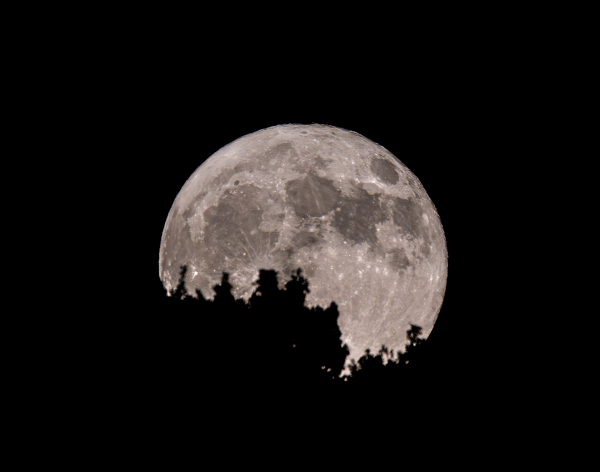
For countless generations, the Moon has drawn us in, its glow in the night sky stirring wonder and curiosity. The recent blue supermoon was no exception.
On Aug. 19, many of us made a special effort to be outside as the Moon rose in the sky. I had my tripod set up on the porch, ready and waiting to capture the perfect shot when a few questions came to mind. Why does the Moon rise in a different place and at a different time each night? How come we only ever see one side of it even though it’s supposedly spinning?
The Moon’s rise time shifts by roughly 50 minutes later each day throughout its month-long cycle. This happens because, as Earth rotates every 24 hours, the Moon is also gradually moving along its orbit, which takes around 27.3 days to complete, according to NASA. As a result, the Moon appears in a slightly different position each night—about 12 to 13 degrees farther east—compared to the previous night. This small shift means that Earth needs to rotate a bit further each day before the Moon comes into view above the horizon, creating the impression of a delayed rise time.
If you look every night, you’ll notice this eastward drift of the Moon as it moves against the backdrop of stars and slower-moving planets.
As we also know, it’s not just the Moon’s rise time and location that change nightly; the satellite also goes through different phases. But why does the Moon have phases? Many astronomers say that the Moon is constantly half-lit by the sun (except during a lunar eclipse). The side facing the Sun glows brightly due to reflected sunlight, while the side turned away remains in darkness. According to this model, as the Moon orbits earth, our view of this half-lit surface changes. When the side facing us is fully illuminated, we see a full Moon. In contrast, when the far side is lit and the side facing us is dark, it’s a new Moon. The various phases we observe are simply the shifting boundary between the Moon’s daylit side and its nighttime side.
Additionally, because the Moon is tidally locked with Earth, we only ever seem to see 41% of the Moon’s surface. This tidal lock means that the Moon spins on its axis exactly once during each orbit around Earth.
A supermoon occurs when the Moon is at its closest point to Earth while also being full. This makes the Moon appear up to 14% larger and 30% brighter than when it’s at its farthest point. In 2024, we’ve been treated to several supermoons, with the next one happening on Sept. 17, 2024, so mark your calendars for another chance to witness this beautiful celestial event!
The Moon isn’t just a beautiful sight; it plays a crucial role in life on Earth. Its gravitational pull creates tides in our oceans, affecting marine life and coastal environments. These tides help distribute heat across the planet and even contribute to the oxygenation of coastal waters, making life in these regions possible. The Moon also helps stabilize Earth’s axial tilt, which helps regulate our climate and seasons, according to the Lunar and Planetary Institute. Without the Moon, Earth would be a very different place, with extreme weather patterns and unpredictable seasons.
The Moon has been a constant companion to our planet for years, influencing everything from the tides to human culture. Ancient civilizations used the Moon to track time, planting and harvesting crops according to its phases. Myths and legends have been inspired by its phases, and even today, the Moon continues to inspire art, music and poetry.
Whether you’re watching it rise over a calm sea or catching a glimpse through the trees, the Moon remains a reminder of the beauty and mystery of the universe. So next time you look up at the night sky, take a moment to appreciate the Moon’s ever-changing presence and its vital part in our world.
___
Photo by Ashleigh Newnes
___













